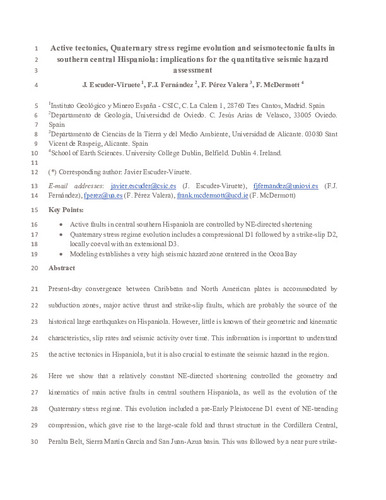Active Tectonics, Quaternary Stress Regime Evolution and Seismotectonic Faults in Southern Central Hispaniola: Implications for the Quantitative Seismic Hazard Assessment.
Autor(es) y otros:
Palabra(s) clave:
Tectónica actica; sismicidad
Fecha de publicación:
Editorial:
AGU
Versión del editor:
Citación:
Resumen:
Present-day convergence between Caribbean and North American plates is accommodated by subduction zones, major active thrust and strike-slip faults, which are probably the source of the historical large earthquakes on Hispaniola. However, little is known of their geometric and kinematic characteristics, slip rates and seismic activity over time. This information is important to understand the active tectonics in Hispaniola, but it is also crucial to estimate the seismic hazard in the region. Here we show that a relatively constant NE-directed shortening controlled the geometry and kinematics of main active faults in central southern Hispaniola, as well as the evolution of the Quaternary stress regime. This evolution included a pre-Early Pleistocene D1 event of NE-trending compression, which gave rise to the large-scale fold and thrust structure in the Cordillera Central, 30 Peralta Belt, Sierra Martín García and San Juan-Azua basin. This was followed by a near pure strikeslip D2 stress regime, partitioned into the N-S to 31 NE-SW transverse Ocoa-Bonao-La Guácara and Beata Ridge fault zones, as well as subordinate structures in related sub-parallel deformation corridors. Shift to D2 strike-slip deformation was related to indentation of the Beata Ridge in southern Hispaniola from the Early to Middle Pleistocene and continues today. D2 was locally coeval by a more heterogeneous and geographically localized D3 extensional deformation. Defined seismotectonic fault zones divide the region into a set of simplified seismogenic zones as starting point for a seismic hazard modeling. Highest peak ground acceleration values computed in the Ocoa Bay establish a very high seismic hazard.
Present-day convergence between Caribbean and North American plates is accommodated by subduction zones, major active thrust and strike-slip faults, which are probably the source of the historical large earthquakes on Hispaniola. However, little is known of their geometric and kinematic characteristics, slip rates and seismic activity over time. This information is important to understand the active tectonics in Hispaniola, but it is also crucial to estimate the seismic hazard in the region. Here we show that a relatively constant NE-directed shortening controlled the geometry and kinematics of main active faults in central southern Hispaniola, as well as the evolution of the Quaternary stress regime. This evolution included a pre-Early Pleistocene D1 event of NE-trending compression, which gave rise to the large-scale fold and thrust structure in the Cordillera Central, 30 Peralta Belt, Sierra Martín García and San Juan-Azua basin. This was followed by a near pure strikeslip D2 stress regime, partitioned into the N-S to 31 NE-SW transverse Ocoa-Bonao-La Guácara and Beata Ridge fault zones, as well as subordinate structures in related sub-parallel deformation corridors. Shift to D2 strike-slip deformation was related to indentation of the Beata Ridge in southern Hispaniola from the Early to Middle Pleistocene and continues today. D2 was locally coeval by a more heterogeneous and geographically localized D3 extensional deformation. Defined seismotectonic fault zones divide the region into a set of simplified seismogenic zones as starting point for a seismic hazard modeling. Highest peak ground acceleration values computed in the Ocoa Bay establish a very high seismic hazard.
DOI:
Patrocinado por:
Ministerio de Ciencia e Innovación. Grant Number: PID2019-105625RB-C22 project of the MCIN/AEI/10.13039/501100011033; Fondo Nacional de Innovación y Desarrollo Científico–Tecnológico. Grant Number: 2015-1b3-118 project; Banco Interamericano de Desarrollo. Grant Number: DR-T 1190 project
Colecciones
- Artículos [37534]
- Geología [548]
- Investigaciones y Documentos OpenAIRE [8322]
Ficheros en el ítem





